Development Economics Report: Global Economic Development Analysis
VerifiedAdded on 2023/01/10
|13
|3309
|91
Report
AI Summary
This report on development economics provides a comprehensive overview of the field, beginning with an introduction to the core concepts and focusing on key variables used to classify countries as developed or developing, such as GDP per capita, GNI, standard of living, employment rates, and income inequality. It then delves into a detailed comparison of developed and developing countries, highlighting seven key characteristics including GDP, industrialization, technology, per capita income, poverty rates, income inequalities, and savings rates. The report further analyzes the implications of global population shifts on GDP and HDI in African countries. Task 2 explores opportunity costs for donor countries, the roles of international bodies like the UN and WTO, and a comparison of international summits (BRICS, G20, ASEAN). The report also examines the positive and negative economic impacts of globalization on developing countries and proposes a long-term development plan with government policies and financing strategies. It concludes with a summary of findings and a list of references.
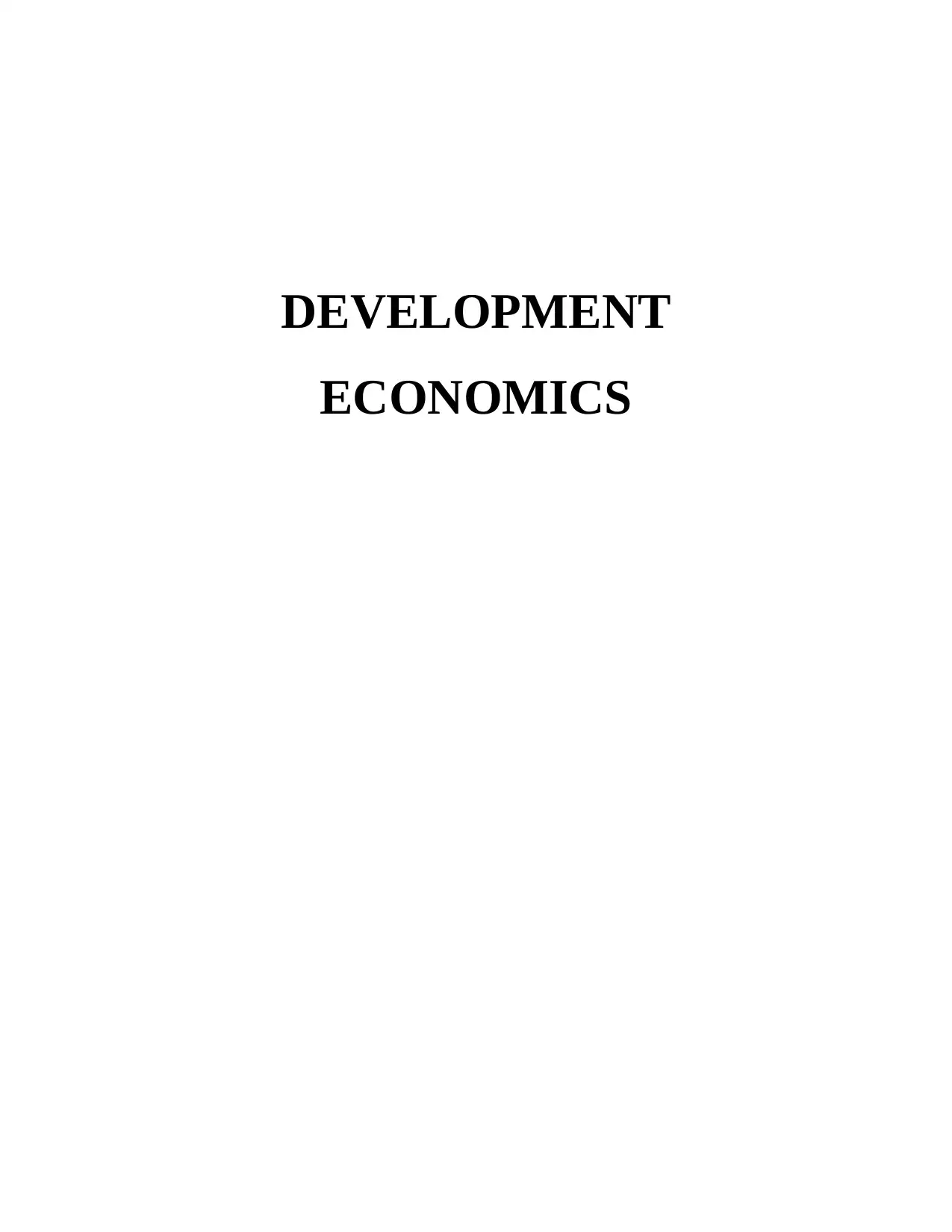
DEVELOPMENT
ECONOMICS
ECONOMICS
Paraphrase This Document
Need a fresh take? Get an instant paraphrase of this document with our AI Paraphraser
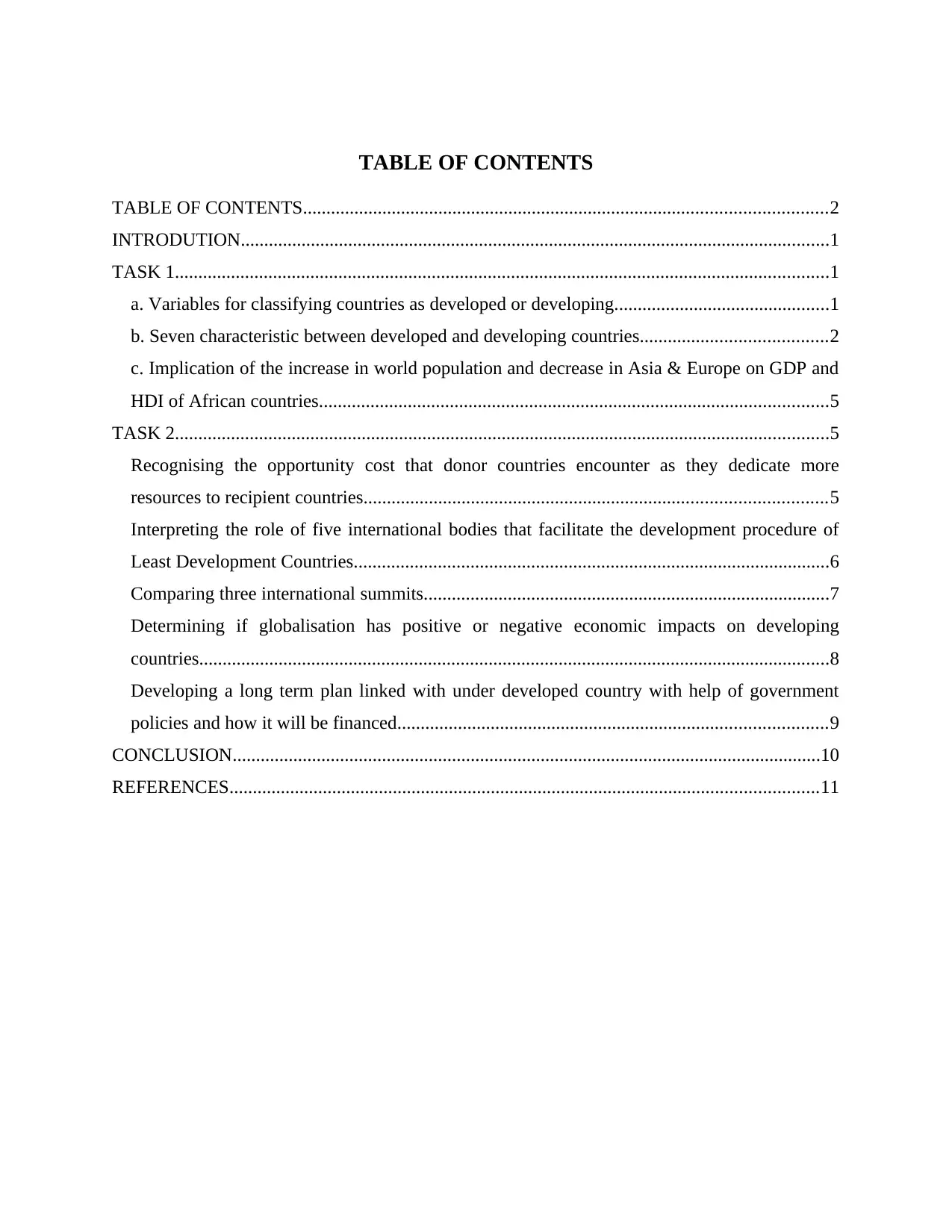
TABLE OF CONTENTS
TABLE OF CONTENTS................................................................................................................2
INTRODUTION..............................................................................................................................1
TASK 1............................................................................................................................................1
a. Variables for classifying countries as developed or developing..............................................1
b. Seven characteristic between developed and developing countries........................................2
c. Implication of the increase in world population and decrease in Asia & Europe on GDP and
HDI of African countries.............................................................................................................5
TASK 2............................................................................................................................................5
Recognising the opportunity cost that donor countries encounter as they dedicate more
resources to recipient countries...................................................................................................5
Interpreting the role of five international bodies that facilitate the development procedure of
Least Development Countries......................................................................................................6
Comparing three international summits.......................................................................................7
Determining if globalisation has positive or negative economic impacts on developing
countries.......................................................................................................................................8
Developing a long term plan linked with under developed country with help of government
policies and how it will be financed............................................................................................9
CONCLUSION..............................................................................................................................10
REFERENCES..............................................................................................................................11
TABLE OF CONTENTS................................................................................................................2
INTRODUTION..............................................................................................................................1
TASK 1............................................................................................................................................1
a. Variables for classifying countries as developed or developing..............................................1
b. Seven characteristic between developed and developing countries........................................2
c. Implication of the increase in world population and decrease in Asia & Europe on GDP and
HDI of African countries.............................................................................................................5
TASK 2............................................................................................................................................5
Recognising the opportunity cost that donor countries encounter as they dedicate more
resources to recipient countries...................................................................................................5
Interpreting the role of five international bodies that facilitate the development procedure of
Least Development Countries......................................................................................................6
Comparing three international summits.......................................................................................7
Determining if globalisation has positive or negative economic impacts on developing
countries.......................................................................................................................................8
Developing a long term plan linked with under developed country with help of government
policies and how it will be financed............................................................................................9
CONCLUSION..............................................................................................................................10
REFERENCES..............................................................................................................................11
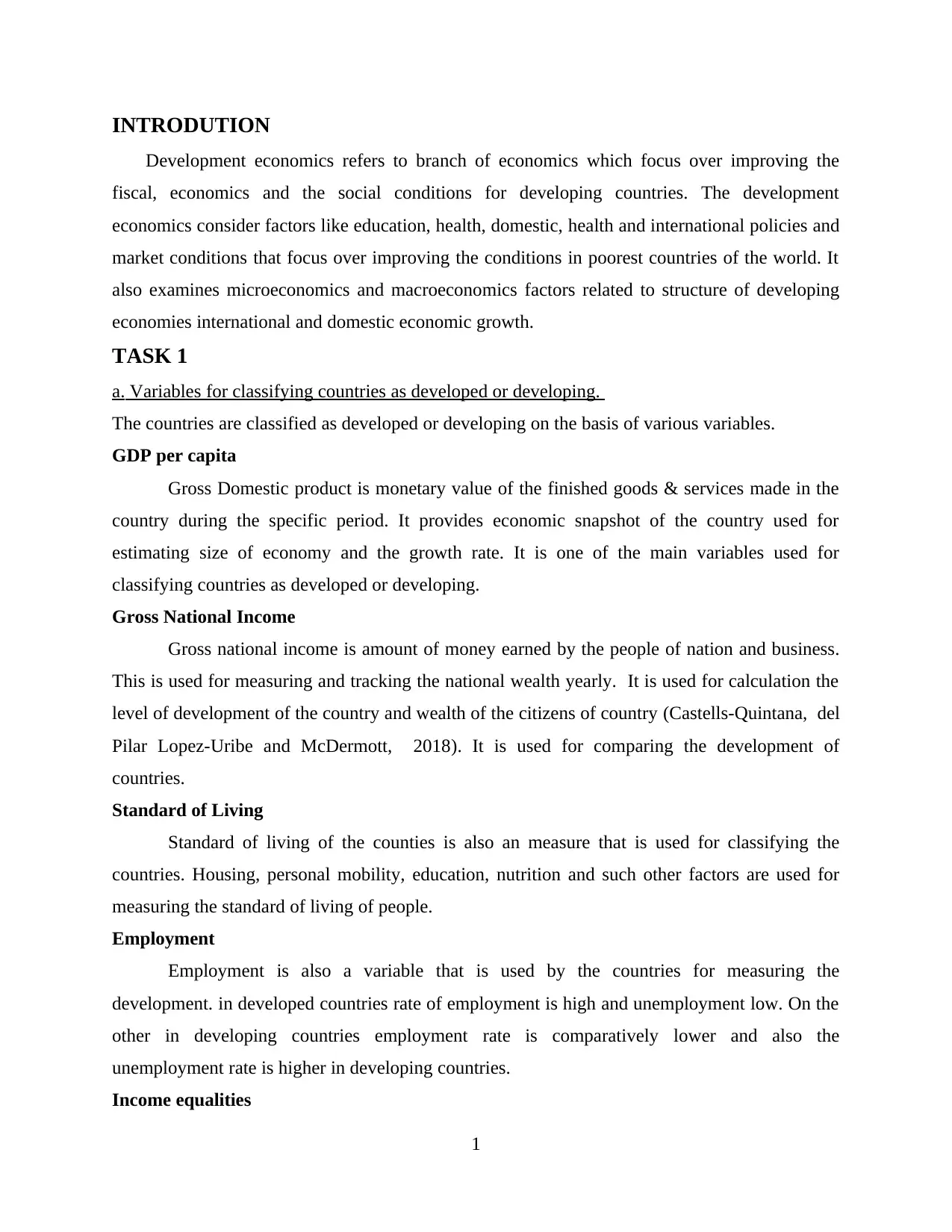
INTRODUTION
Development economics refers to branch of economics which focus over improving the
fiscal, economics and the social conditions for developing countries. The development
economics consider factors like education, health, domestic, health and international policies and
market conditions that focus over improving the conditions in poorest countries of the world. It
also examines microeconomics and macroeconomics factors related to structure of developing
economies international and domestic economic growth.
TASK 1
a. Variables for classifying countries as developed or developing.
The countries are classified as developed or developing on the basis of various variables.
GDP per capita
Gross Domestic product is monetary value of the finished goods & services made in the
country during the specific period. It provides economic snapshot of the country used for
estimating size of economy and the growth rate. It is one of the main variables used for
classifying countries as developed or developing.
Gross National Income
Gross national income is amount of money earned by the people of nation and business.
This is used for measuring and tracking the national wealth yearly. It is used for calculation the
level of development of the country and wealth of the citizens of country (Castells-Quintana, del
Pilar Lopez-Uribe and McDermott, 2018). It is used for comparing the development of
countries.
Standard of Living
Standard of living of the counties is also an measure that is used for classifying the
countries. Housing, personal mobility, education, nutrition and such other factors are used for
measuring the standard of living of people.
Employment
Employment is also a variable that is used by the countries for measuring the
development. in developed countries rate of employment is high and unemployment low. On the
other in developing countries employment rate is comparatively lower and also the
unemployment rate is higher in developing countries.
Income equalities
1
Development economics refers to branch of economics which focus over improving the
fiscal, economics and the social conditions for developing countries. The development
economics consider factors like education, health, domestic, health and international policies and
market conditions that focus over improving the conditions in poorest countries of the world. It
also examines microeconomics and macroeconomics factors related to structure of developing
economies international and domestic economic growth.
TASK 1
a. Variables for classifying countries as developed or developing.
The countries are classified as developed or developing on the basis of various variables.
GDP per capita
Gross Domestic product is monetary value of the finished goods & services made in the
country during the specific period. It provides economic snapshot of the country used for
estimating size of economy and the growth rate. It is one of the main variables used for
classifying countries as developed or developing.
Gross National Income
Gross national income is amount of money earned by the people of nation and business.
This is used for measuring and tracking the national wealth yearly. It is used for calculation the
level of development of the country and wealth of the citizens of country (Castells-Quintana, del
Pilar Lopez-Uribe and McDermott, 2018). It is used for comparing the development of
countries.
Standard of Living
Standard of living of the counties is also an measure that is used for classifying the
countries. Housing, personal mobility, education, nutrition and such other factors are used for
measuring the standard of living of people.
Employment
Employment is also a variable that is used by the countries for measuring the
development. in developed countries rate of employment is high and unemployment low. On the
other in developing countries employment rate is comparatively lower and also the
unemployment rate is higher in developing countries.
Income equalities
1
⊘ This is a preview!⊘
Do you want full access?
Subscribe today to unlock all pages.

Trusted by 1+ million students worldwide
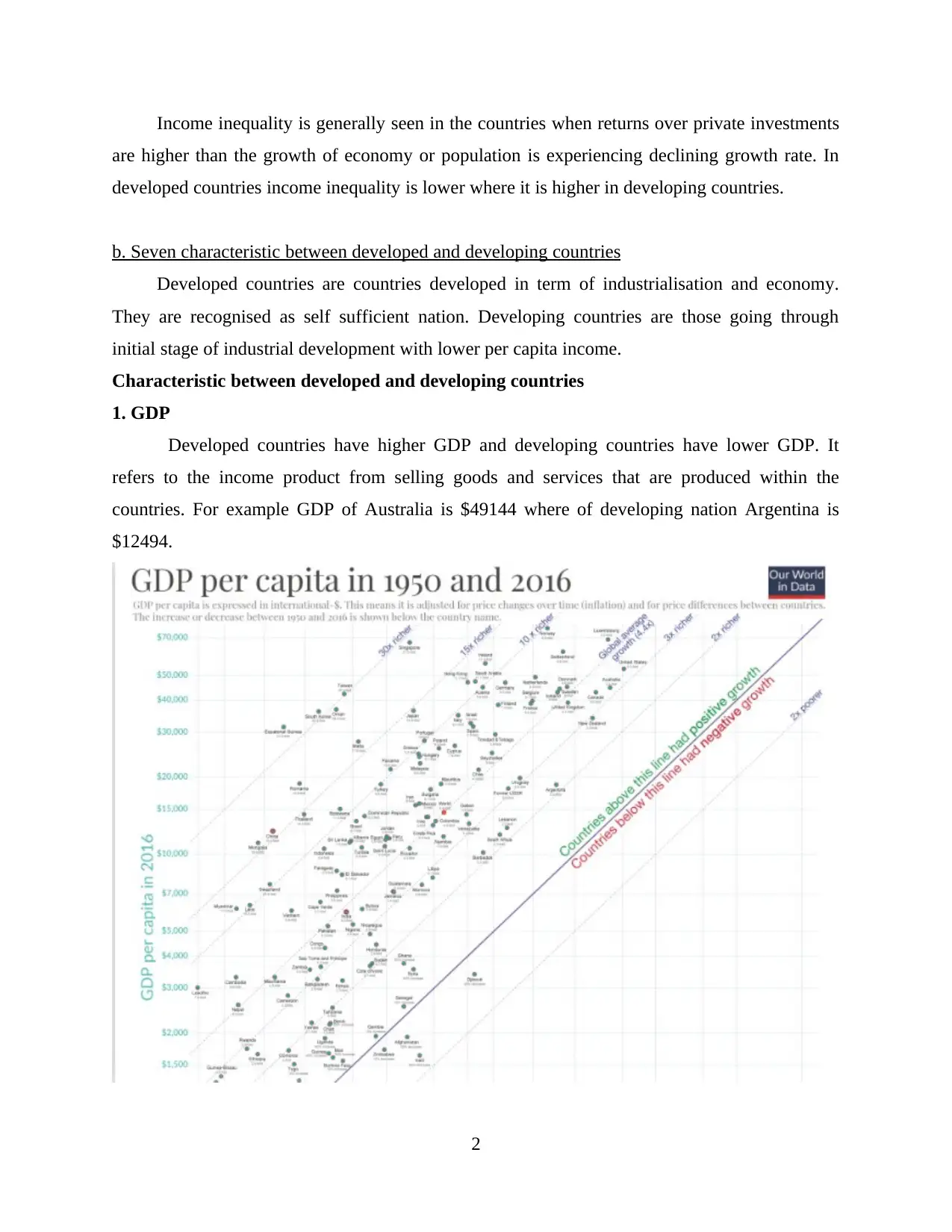
Income inequality is generally seen in the countries when returns over private investments
are higher than the growth of economy or population is experiencing declining growth rate. In
developed countries income inequality is lower where it is higher in developing countries.
b. Seven characteristic between developed and developing countries
Developed countries are countries developed in term of industrialisation and economy.
They are recognised as self sufficient nation. Developing countries are those going through
initial stage of industrial development with lower per capita income.
Characteristic between developed and developing countries
1. GDP
Developed countries have higher GDP and developing countries have lower GDP. It
refers to the income product from selling goods and services that are produced within the
countries. For example GDP of Australia is $49144 where of developing nation Argentina is
$12494.
2
are higher than the growth of economy or population is experiencing declining growth rate. In
developed countries income inequality is lower where it is higher in developing countries.
b. Seven characteristic between developed and developing countries
Developed countries are countries developed in term of industrialisation and economy.
They are recognised as self sufficient nation. Developing countries are those going through
initial stage of industrial development with lower per capita income.
Characteristic between developed and developing countries
1. GDP
Developed countries have higher GDP and developing countries have lower GDP. It
refers to the income product from selling goods and services that are produced within the
countries. For example GDP of Australia is $49144 where of developing nation Argentina is
$12494.
2
Paraphrase This Document
Need a fresh take? Get an instant paraphrase of this document with our AI Paraphraser
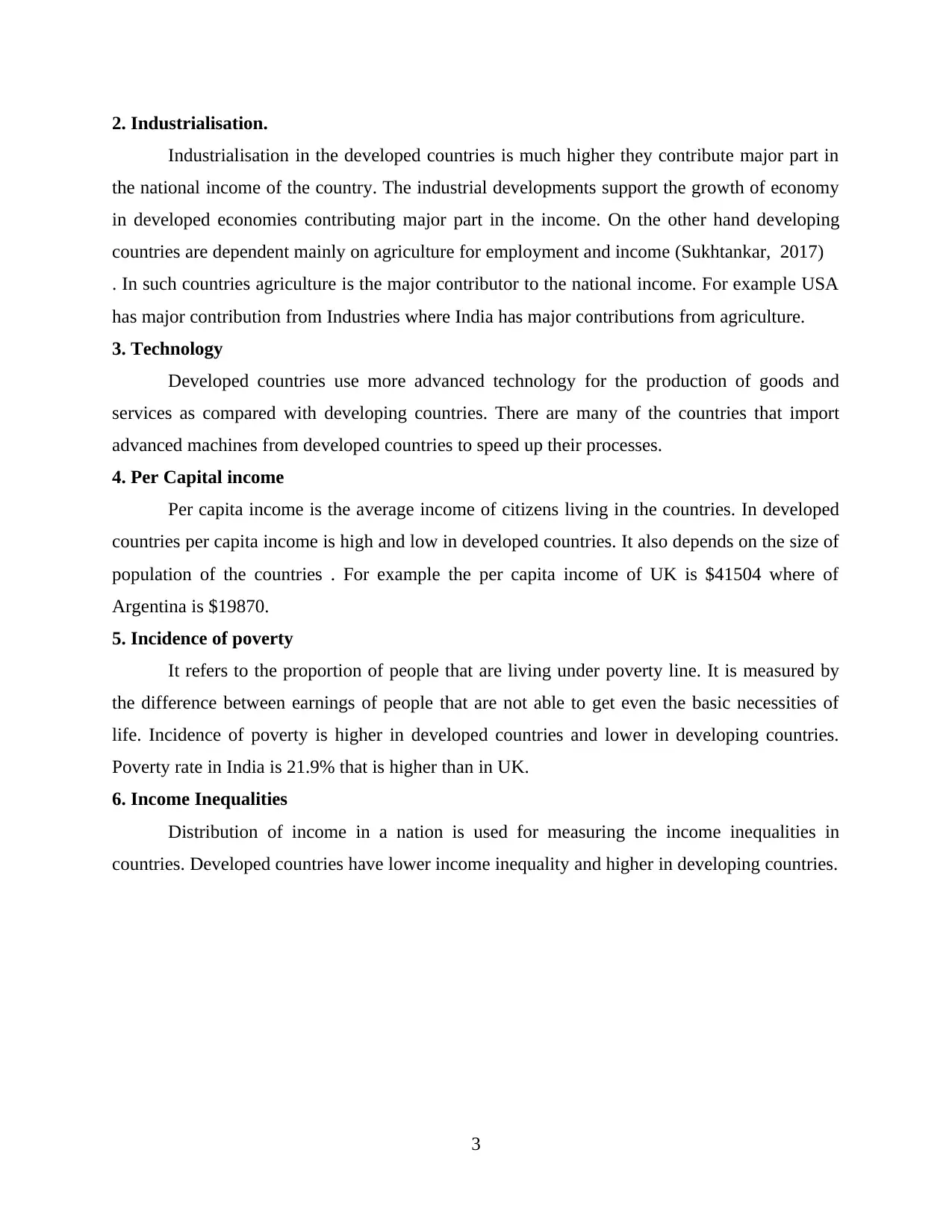
2. Industrialisation.
Industrialisation in the developed countries is much higher they contribute major part in
the national income of the country. The industrial developments support the growth of economy
in developed economies contributing major part in the income. On the other hand developing
countries are dependent mainly on agriculture for employment and income (Sukhtankar, 2017)
. In such countries agriculture is the major contributor to the national income. For example USA
has major contribution from Industries where India has major contributions from agriculture.
3. Technology
Developed countries use more advanced technology for the production of goods and
services as compared with developing countries. There are many of the countries that import
advanced machines from developed countries to speed up their processes.
4. Per Capital income
Per capita income is the average income of citizens living in the countries. In developed
countries per capita income is high and low in developed countries. It also depends on the size of
population of the countries . For example the per capita income of UK is $41504 where of
Argentina is $19870.
5. Incidence of poverty
It refers to the proportion of people that are living under poverty line. It is measured by
the difference between earnings of people that are not able to get even the basic necessities of
life. Incidence of poverty is higher in developed countries and lower in developing countries.
Poverty rate in India is 21.9% that is higher than in UK.
6. Income Inequalities
Distribution of income in a nation is used for measuring the income inequalities in
countries. Developed countries have lower income inequality and higher in developing countries.
3
Industrialisation in the developed countries is much higher they contribute major part in
the national income of the country. The industrial developments support the growth of economy
in developed economies contributing major part in the income. On the other hand developing
countries are dependent mainly on agriculture for employment and income (Sukhtankar, 2017)
. In such countries agriculture is the major contributor to the national income. For example USA
has major contribution from Industries where India has major contributions from agriculture.
3. Technology
Developed countries use more advanced technology for the production of goods and
services as compared with developing countries. There are many of the countries that import
advanced machines from developed countries to speed up their processes.
4. Per Capital income
Per capita income is the average income of citizens living in the countries. In developed
countries per capita income is high and low in developed countries. It also depends on the size of
population of the countries . For example the per capita income of UK is $41504 where of
Argentina is $19870.
5. Incidence of poverty
It refers to the proportion of people that are living under poverty line. It is measured by
the difference between earnings of people that are not able to get even the basic necessities of
life. Incidence of poverty is higher in developed countries and lower in developing countries.
Poverty rate in India is 21.9% that is higher than in UK.
6. Income Inequalities
Distribution of income in a nation is used for measuring the income inequalities in
countries. Developed countries have lower income inequality and higher in developing countries.
3
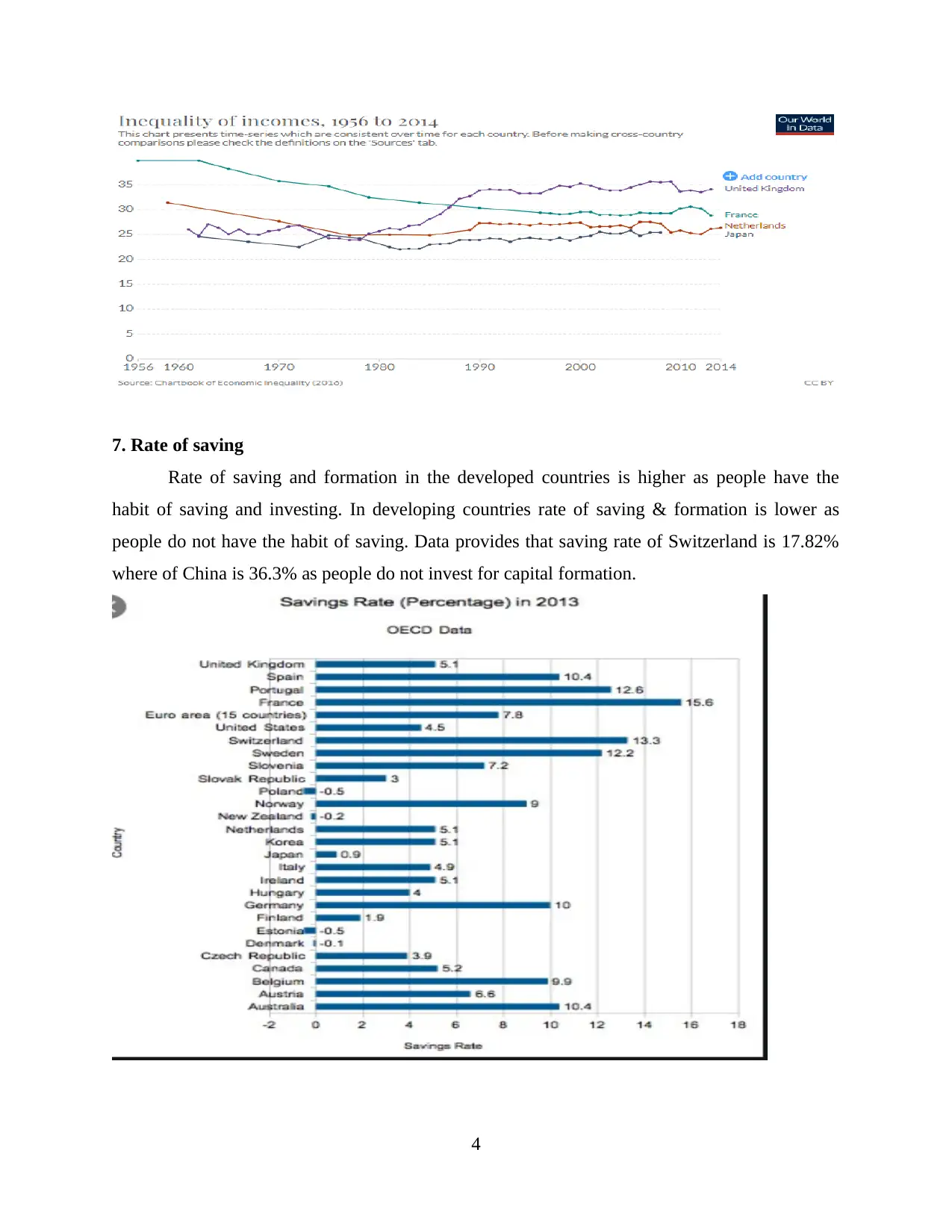
7. Rate of saving
Rate of saving and formation in the developed countries is higher as people have the
habit of saving and investing. In developing countries rate of saving & formation is lower as
people do not have the habit of saving. Data provides that saving rate of Switzerland is 17.82%
where of China is 36.3% as people do not invest for capital formation.
4
Rate of saving and formation in the developed countries is higher as people have the
habit of saving and investing. In developing countries rate of saving & formation is lower as
people do not have the habit of saving. Data provides that saving rate of Switzerland is 17.82%
where of China is 36.3% as people do not invest for capital formation.
4
⊘ This is a preview!⊘
Do you want full access?
Subscribe today to unlock all pages.

Trusted by 1+ million students worldwide
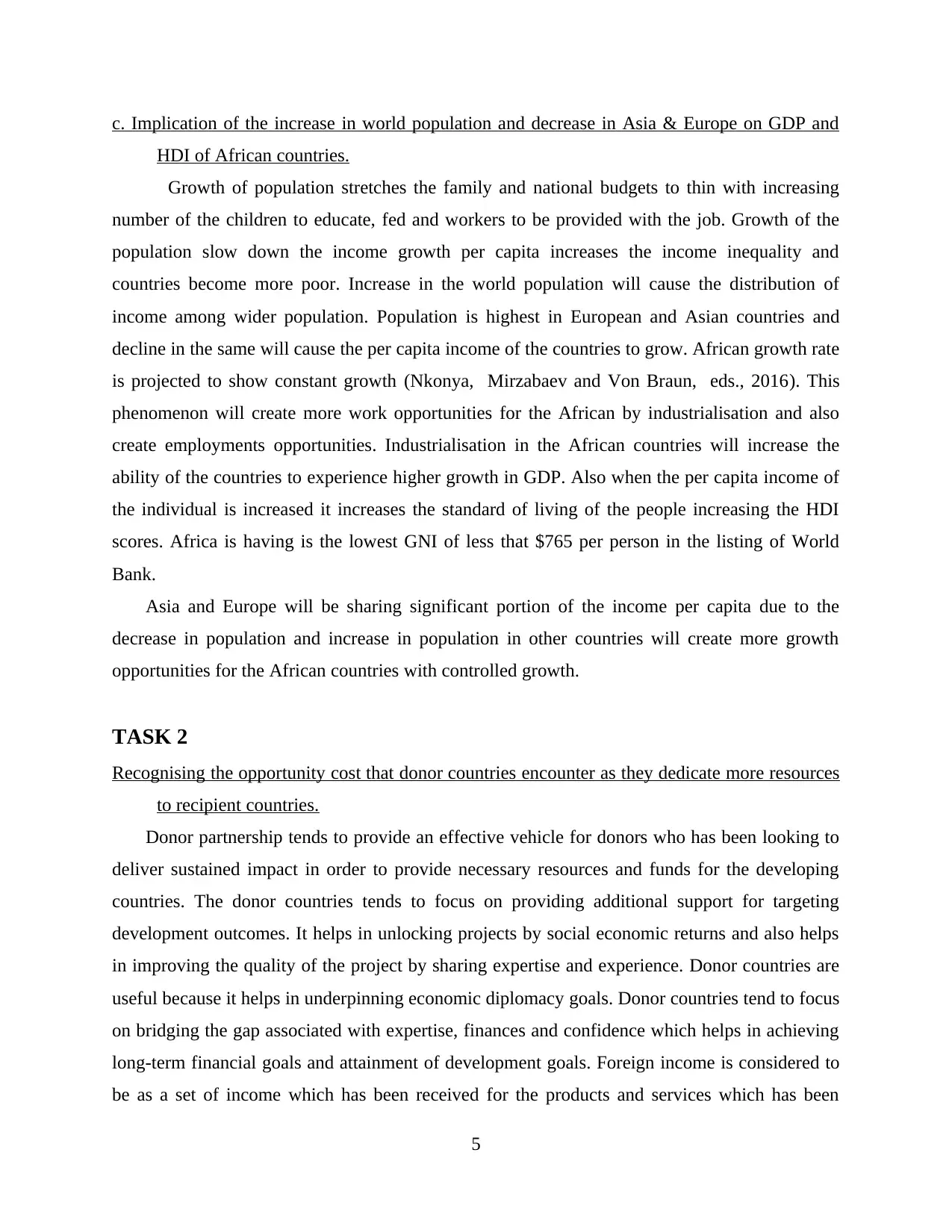
c. Implication of the increase in world population and decrease in Asia & Europe on GDP and
HDI of African countries.
Growth of population stretches the family and national budgets to thin with increasing
number of the children to educate, fed and workers to be provided with the job. Growth of the
population slow down the income growth per capita increases the income inequality and
countries become more poor. Increase in the world population will cause the distribution of
income among wider population. Population is highest in European and Asian countries and
decline in the same will cause the per capita income of the countries to grow. African growth rate
is projected to show constant growth (Nkonya, Mirzabaev and Von Braun, eds., 2016). This
phenomenon will create more work opportunities for the African by industrialisation and also
create employments opportunities. Industrialisation in the African countries will increase the
ability of the countries to experience higher growth in GDP. Also when the per capita income of
the individual is increased it increases the standard of living of the people increasing the HDI
scores. Africa is having is the lowest GNI of less that $765 per person in the listing of World
Bank.
Asia and Europe will be sharing significant portion of the income per capita due to the
decrease in population and increase in population in other countries will create more growth
opportunities for the African countries with controlled growth.
TASK 2
Recognising the opportunity cost that donor countries encounter as they dedicate more resources
to recipient countries.
Donor partnership tends to provide an effective vehicle for donors who has been looking to
deliver sustained impact in order to provide necessary resources and funds for the developing
countries. The donor countries tends to focus on providing additional support for targeting
development outcomes. It helps in unlocking projects by social economic returns and also helps
in improving the quality of the project by sharing expertise and experience. Donor countries are
useful because it helps in underpinning economic diplomacy goals. Donor countries tend to focus
on bridging the gap associated with expertise, finances and confidence which helps in achieving
long-term financial goals and attainment of development goals. Foreign income is considered to
be as a set of income which has been received for the products and services which has been
5
HDI of African countries.
Growth of population stretches the family and national budgets to thin with increasing
number of the children to educate, fed and workers to be provided with the job. Growth of the
population slow down the income growth per capita increases the income inequality and
countries become more poor. Increase in the world population will cause the distribution of
income among wider population. Population is highest in European and Asian countries and
decline in the same will cause the per capita income of the countries to grow. African growth rate
is projected to show constant growth (Nkonya, Mirzabaev and Von Braun, eds., 2016). This
phenomenon will create more work opportunities for the African by industrialisation and also
create employments opportunities. Industrialisation in the African countries will increase the
ability of the countries to experience higher growth in GDP. Also when the per capita income of
the individual is increased it increases the standard of living of the people increasing the HDI
scores. Africa is having is the lowest GNI of less that $765 per person in the listing of World
Bank.
Asia and Europe will be sharing significant portion of the income per capita due to the
decrease in population and increase in population in other countries will create more growth
opportunities for the African countries with controlled growth.
TASK 2
Recognising the opportunity cost that donor countries encounter as they dedicate more resources
to recipient countries.
Donor partnership tends to provide an effective vehicle for donors who has been looking to
deliver sustained impact in order to provide necessary resources and funds for the developing
countries. The donor countries tends to focus on providing additional support for targeting
development outcomes. It helps in unlocking projects by social economic returns and also helps
in improving the quality of the project by sharing expertise and experience. Donor countries are
useful because it helps in underpinning economic diplomacy goals. Donor countries tend to focus
on bridging the gap associated with expertise, finances and confidence which helps in achieving
long-term financial goals and attainment of development goals. Foreign income is considered to
be as a set of income which has been received for the products and services which has been
5
Paraphrase This Document
Need a fresh take? Get an instant paraphrase of this document with our AI Paraphraser

performed within a foreign country in a particular period. It is considered to be an asset and
improve the revenue of the country. The United States is considered to be one of the most
prominent donor countries which contributes billion dollars within the foreign aid. Malta a flat
tax rate of 15% has been charged on the foreign income which has been remitted to
Malta. Economic is the root of allocation of scarce resources for the production of the various
range of products and services. However in order to produce more goods and services the
country must forego the opportunity in order to produce more goods and services.
Interpreting the role of five international bodies that facilitate the development procedure of
Least Development Countries.
Least developed countries is considered to be a list of developing countries associated with
the United nation which exhibits low indicators of human development index and social
economic development from the countries across the globe (Bishop, and Aylward, 2019). The
international bodies are considered to be the organisation which has been established by a treaty
which are governed by prescribed set of international laws and legal personality in order to
facilitate the development procedure of lease development countries. United Nations, European
Union, World Trade Organisation, north Atlantic Treaty organisation, group of 20 are considered
to be the key international bodies who work towards the development of least development
countries.
Group of 20 is one of the international body which helps in facilitating the procedure of
development of least developing countries. It helps in systematically bringing together
developing economies together in order to prominently discuss about the key issues associated
with the global economy.
United nation is considered to be as an intergovernmental organisation which mainly aims to
focus on maintaining peace and security is whether international countries. It also focuses on
developing friendly relations among various nations in order to achieve International cooperation
by harmonising the actions associated with the nation.
The European Union tends to focus on maintaining external relations and also focuses on
maintaining permanent diplomatic missions across the globe. It is one of the most effective
approaches in and say it can Amit, territorial, solidarity, social diversity among the European
countries. European Union is considered to be one of the most prominent trading partner for the
6
improve the revenue of the country. The United States is considered to be one of the most
prominent donor countries which contributes billion dollars within the foreign aid. Malta a flat
tax rate of 15% has been charged on the foreign income which has been remitted to
Malta. Economic is the root of allocation of scarce resources for the production of the various
range of products and services. However in order to produce more goods and services the
country must forego the opportunity in order to produce more goods and services.
Interpreting the role of five international bodies that facilitate the development procedure of
Least Development Countries.
Least developed countries is considered to be a list of developing countries associated with
the United nation which exhibits low indicators of human development index and social
economic development from the countries across the globe (Bishop, and Aylward, 2019). The
international bodies are considered to be the organisation which has been established by a treaty
which are governed by prescribed set of international laws and legal personality in order to
facilitate the development procedure of lease development countries. United Nations, European
Union, World Trade Organisation, north Atlantic Treaty organisation, group of 20 are considered
to be the key international bodies who work towards the development of least development
countries.
Group of 20 is one of the international body which helps in facilitating the procedure of
development of least developing countries. It helps in systematically bringing together
developing economies together in order to prominently discuss about the key issues associated
with the global economy.
United nation is considered to be as an intergovernmental organisation which mainly aims to
focus on maintaining peace and security is whether international countries. It also focuses on
developing friendly relations among various nations in order to achieve International cooperation
by harmonising the actions associated with the nation.
The European Union tends to focus on maintaining external relations and also focuses on
maintaining permanent diplomatic missions across the globe. It is one of the most effective
approaches in and say it can Amit, territorial, solidarity, social diversity among the European
countries. European Union is considered to be one of the most prominent trading partner for the
6
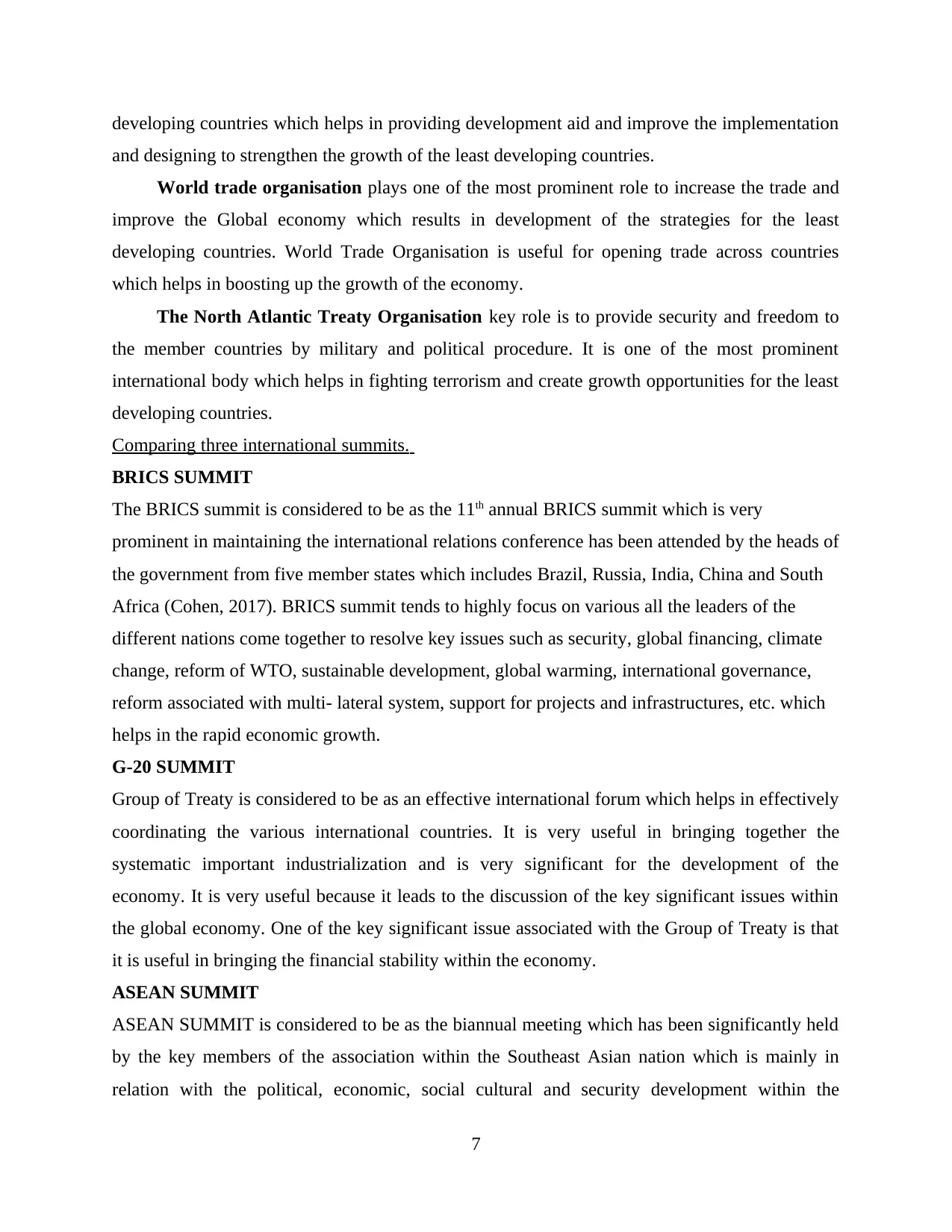
developing countries which helps in providing development aid and improve the implementation
and designing to strengthen the growth of the least developing countries.
World trade organisation plays one of the most prominent role to increase the trade and
improve the Global economy which results in development of the strategies for the least
developing countries. World Trade Organisation is useful for opening trade across countries
which helps in boosting up the growth of the economy.
The North Atlantic Treaty Organisation key role is to provide security and freedom to
the member countries by military and political procedure. It is one of the most prominent
international body which helps in fighting terrorism and create growth opportunities for the least
developing countries.
Comparing three international summits.
BRICS SUMMIT
The BRICS summit is considered to be as the 11th annual BRICS summit which is very
prominent in maintaining the international relations conference has been attended by the heads of
the government from five member states which includes Brazil, Russia, India, China and South
Africa (Cohen, 2017). BRICS summit tends to highly focus on various all the leaders of the
different nations come together to resolve key issues such as security, global financing, climate
change, reform of WTO, sustainable development, global warming, international governance,
reform associated with multi- lateral system, support for projects and infrastructures, etc. which
helps in the rapid economic growth.
G-20 SUMMIT
Group of Treaty is considered to be as an effective international forum which helps in effectively
coordinating the various international countries. It is very useful in bringing together the
systematic important industrialization and is very significant for the development of the
economy. It is very useful because it leads to the discussion of the key significant issues within
the global economy. One of the key significant issue associated with the Group of Treaty is that
it is useful in bringing the financial stability within the economy.
ASEAN SUMMIT
ASEAN SUMMIT is considered to be as the biannual meeting which has been significantly held
by the key members of the association within the Southeast Asian nation which is mainly in
relation with the political, economic, social cultural and security development within the
7
and designing to strengthen the growth of the least developing countries.
World trade organisation plays one of the most prominent role to increase the trade and
improve the Global economy which results in development of the strategies for the least
developing countries. World Trade Organisation is useful for opening trade across countries
which helps in boosting up the growth of the economy.
The North Atlantic Treaty Organisation key role is to provide security and freedom to
the member countries by military and political procedure. It is one of the most prominent
international body which helps in fighting terrorism and create growth opportunities for the least
developing countries.
Comparing three international summits.
BRICS SUMMIT
The BRICS summit is considered to be as the 11th annual BRICS summit which is very
prominent in maintaining the international relations conference has been attended by the heads of
the government from five member states which includes Brazil, Russia, India, China and South
Africa (Cohen, 2017). BRICS summit tends to highly focus on various all the leaders of the
different nations come together to resolve key issues such as security, global financing, climate
change, reform of WTO, sustainable development, global warming, international governance,
reform associated with multi- lateral system, support for projects and infrastructures, etc. which
helps in the rapid economic growth.
G-20 SUMMIT
Group of Treaty is considered to be as an effective international forum which helps in effectively
coordinating the various international countries. It is very useful in bringing together the
systematic important industrialization and is very significant for the development of the
economy. It is very useful because it leads to the discussion of the key significant issues within
the global economy. One of the key significant issue associated with the Group of Treaty is that
it is useful in bringing the financial stability within the economy.
ASEAN SUMMIT
ASEAN SUMMIT is considered to be as the biannual meeting which has been significantly held
by the key members of the association within the Southeast Asian nation which is mainly in
relation with the political, economic, social cultural and security development within the
7
⊘ This is a preview!⊘
Do you want full access?
Subscribe today to unlock all pages.

Trusted by 1+ million students worldwide
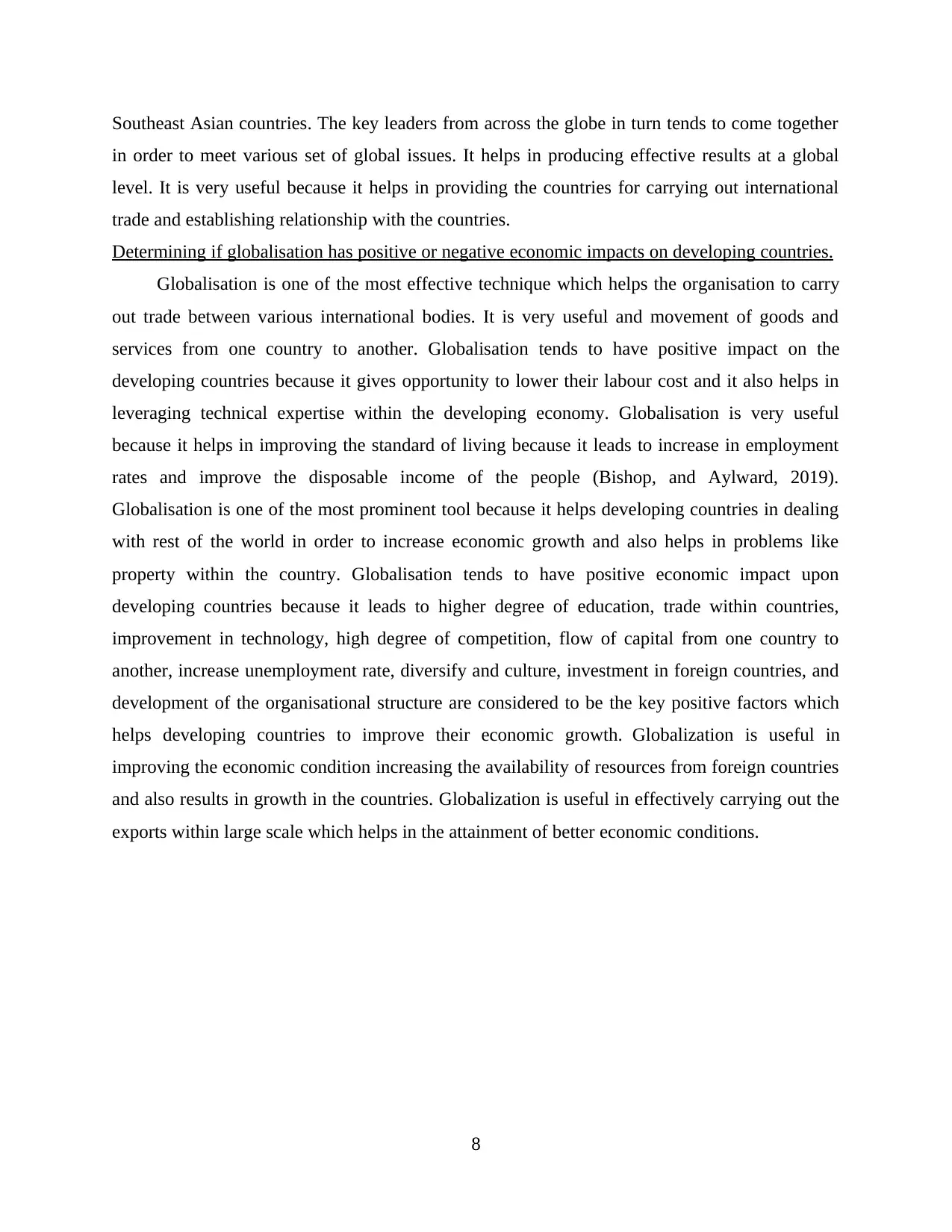
Southeast Asian countries. The key leaders from across the globe in turn tends to come together
in order to meet various set of global issues. It helps in producing effective results at a global
level. It is very useful because it helps in providing the countries for carrying out international
trade and establishing relationship with the countries.
Determining if globalisation has positive or negative economic impacts on developing countries.
Globalisation is one of the most effective technique which helps the organisation to carry
out trade between various international bodies. It is very useful and movement of goods and
services from one country to another. Globalisation tends to have positive impact on the
developing countries because it gives opportunity to lower their labour cost and it also helps in
leveraging technical expertise within the developing economy. Globalisation is very useful
because it helps in improving the standard of living because it leads to increase in employment
rates and improve the disposable income of the people (Bishop, and Aylward, 2019).
Globalisation is one of the most prominent tool because it helps developing countries in dealing
with rest of the world in order to increase economic growth and also helps in problems like
property within the country. Globalisation tends to have positive economic impact upon
developing countries because it leads to higher degree of education, trade within countries,
improvement in technology, high degree of competition, flow of capital from one country to
another, increase unemployment rate, diversify and culture, investment in foreign countries, and
development of the organisational structure are considered to be the key positive factors which
helps developing countries to improve their economic growth. Globalization is useful in
improving the economic condition increasing the availability of resources from foreign countries
and also results in growth in the countries. Globalization is useful in effectively carrying out the
exports within large scale which helps in the attainment of better economic conditions.
8
in order to meet various set of global issues. It helps in producing effective results at a global
level. It is very useful because it helps in providing the countries for carrying out international
trade and establishing relationship with the countries.
Determining if globalisation has positive or negative economic impacts on developing countries.
Globalisation is one of the most effective technique which helps the organisation to carry
out trade between various international bodies. It is very useful and movement of goods and
services from one country to another. Globalisation tends to have positive impact on the
developing countries because it gives opportunity to lower their labour cost and it also helps in
leveraging technical expertise within the developing economy. Globalisation is very useful
because it helps in improving the standard of living because it leads to increase in employment
rates and improve the disposable income of the people (Bishop, and Aylward, 2019).
Globalisation is one of the most prominent tool because it helps developing countries in dealing
with rest of the world in order to increase economic growth and also helps in problems like
property within the country. Globalisation tends to have positive economic impact upon
developing countries because it leads to higher degree of education, trade within countries,
improvement in technology, high degree of competition, flow of capital from one country to
another, increase unemployment rate, diversify and culture, investment in foreign countries, and
development of the organisational structure are considered to be the key positive factors which
helps developing countries to improve their economic growth. Globalization is useful in
improving the economic condition increasing the availability of resources from foreign countries
and also results in growth in the countries. Globalization is useful in effectively carrying out the
exports within large scale which helps in the attainment of better economic conditions.
8
Paraphrase This Document
Need a fresh take? Get an instant paraphrase of this document with our AI Paraphraser

Figure 1Global export timeline
Developing a long term plan linked with under developed country with help of government
policies and how it will be financed
In this highly globalised and competitive market it is very essential for the countries to get
developed so that they can also have global market position. Thus, for this the country Angola is
used. This is because this is an underdeveloped country which is trying to develop the country in
order to improve its working and financial stability. Thus, for this the major policy of the
government of country is to promote more of FDI that if Foreign Direct Investment. This is
essential for the development of the country as this policy will bring in more of the foreign
currency and this will help the company in gaining more good and effective position within the
whole world. Also, the government of Angola must include some of the merger options with
bigger companies of developed country. This will increase the employment within the company
and will be helpful for the country to grow and develop into a developing and later in developed
stage.
For the purpose of finance the country Angola can for taking loans from banks and financial
9
Developing a long term plan linked with under developed country with help of government
policies and how it will be financed
In this highly globalised and competitive market it is very essential for the countries to get
developed so that they can also have global market position. Thus, for this the country Angola is
used. This is because this is an underdeveloped country which is trying to develop the country in
order to improve its working and financial stability. Thus, for this the major policy of the
government of country is to promote more of FDI that if Foreign Direct Investment. This is
essential for the development of the country as this policy will bring in more of the foreign
currency and this will help the company in gaining more good and effective position within the
whole world. Also, the government of Angola must include some of the merger options with
bigger companies of developed country. This will increase the employment within the company
and will be helpful for the country to grow and develop into a developing and later in developed
stage.
For the purpose of finance the country Angola can for taking loans from banks and financial
9

institution. This will assist the country in getting the money at lower rates of interest and this will
be helpful for the development of country. Also the other important source of getting finance is
the loan or helps to be taken from the developed countries (Kremer, Rao and Schilbach, 2019).
This is a good source as if the relation of underdeveloped country will be good with the
developed country then the country might provide for interest free help to Angola. Thus, this will
result in decrease in the expense of paying interest to the country from which help is being taken.
This will result in company trying to climb on the ladder of success and this will help country in
getting at the stage of developing country.
CONCLUSION
This study summarizes that, GDP per capita, Gross National Income, Standard of Living,
Employment and income inequalities are key factors which classifies developed or developing
countries. The industrial developments support the growth of economy in developed economies
contributing major part in the income. The donor countries tends to focus on providing additional
support for targeting development outcomes. . It has been summarized that, United Nations,
European Union, World Trade Organisation, north Atlantic Treaty organisation, group of 20 are
considered to be the key international bodies who work towards the development of least
development countries. BRICS summit, Group of Treaty and ASEAN SUMMIT is considered to
be key international summits. Globalisation is very useful because it helps in improving the
standard of living because it leads to increase in employment rates. It has been summarized that,
Globalization is useful in improving the economic condition increasing the availability of
resources from foreign countries and also results in growth in the countries.
10
be helpful for the development of country. Also the other important source of getting finance is
the loan or helps to be taken from the developed countries (Kremer, Rao and Schilbach, 2019).
This is a good source as if the relation of underdeveloped country will be good with the
developed country then the country might provide for interest free help to Angola. Thus, this will
result in decrease in the expense of paying interest to the country from which help is being taken.
This will result in company trying to climb on the ladder of success and this will help country in
getting at the stage of developing country.
CONCLUSION
This study summarizes that, GDP per capita, Gross National Income, Standard of Living,
Employment and income inequalities are key factors which classifies developed or developing
countries. The industrial developments support the growth of economy in developed economies
contributing major part in the income. The donor countries tends to focus on providing additional
support for targeting development outcomes. . It has been summarized that, United Nations,
European Union, World Trade Organisation, north Atlantic Treaty organisation, group of 20 are
considered to be the key international bodies who work towards the development of least
development countries. BRICS summit, Group of Treaty and ASEAN SUMMIT is considered to
be key international summits. Globalisation is very useful because it helps in improving the
standard of living because it leads to increase in employment rates. It has been summarized that,
Globalization is useful in improving the economic condition increasing the availability of
resources from foreign countries and also results in growth in the countries.
10
⊘ This is a preview!⊘
Do you want full access?
Subscribe today to unlock all pages.

Trusted by 1+ million students worldwide
1 out of 13
Related Documents
Your All-in-One AI-Powered Toolkit for Academic Success.
+13062052269
info@desklib.com
Available 24*7 on WhatsApp / Email
![[object Object]](/_next/static/media/star-bottom.7253800d.svg)
Unlock your academic potential
Copyright © 2020–2025 A2Z Services. All Rights Reserved. Developed and managed by ZUCOL.





